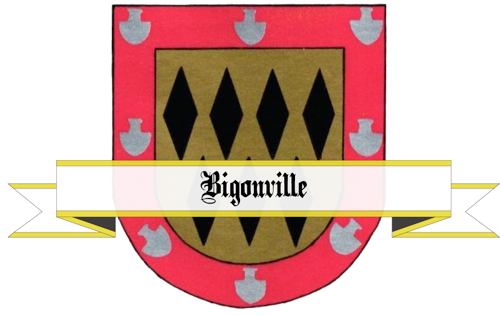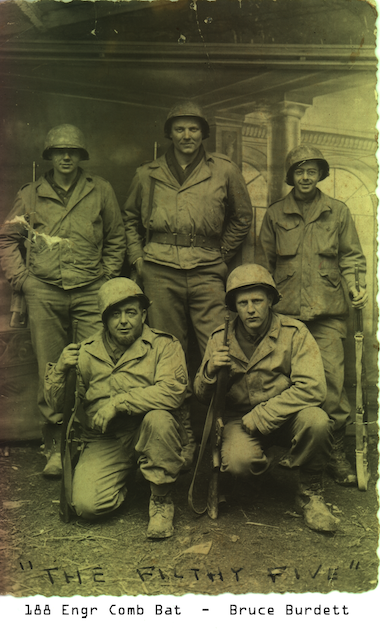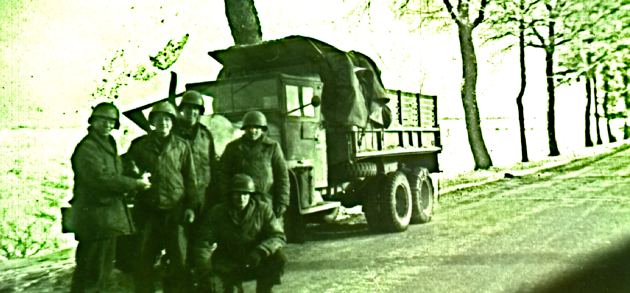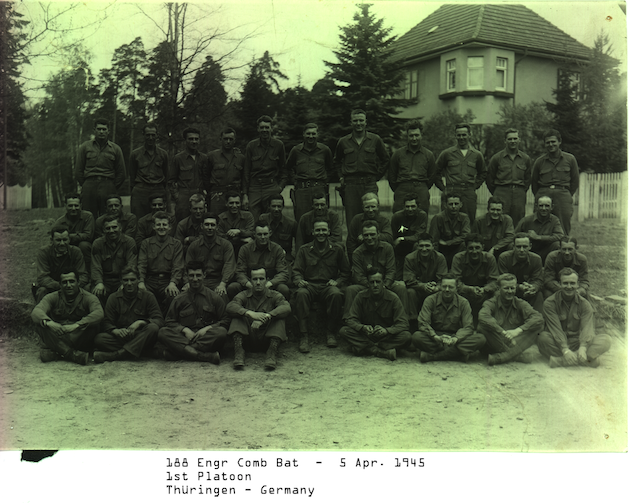23 - 24 December 1944
In December of 1944 I was a Sergeant (Squad Leader) in Company C, 188th Engineer Combat Battalion, which was operating then in support of 4th Armored Division, Third Army.
By December 22, General Patton’s Third Army had made its astonishing 48-hour shift from attacking east at Saare-Union, France, to attacking north in Belgium in an effort to squeeze off the so-called Bulge from its south shoulder and relieve the surrounded American forces at Bastogne. The 4th Armored was the spearhead division, with the Bastogne perimeter as its specific short-term goal.
As soon as darkness fell on the night of December 23, I was ordered to take my squad - a half-squad of eight men, actually - to a point just inside Luxembourg on the road that ran through the woods from the railroad stop at Flatzbour toward the village called Koetschette, and there to set up a roadblock facing east. The latter village, about a quarter-mile in front of our position, lay in a narrow no-man’s-land between 4th Armored and the 26th Infantry Division, both of which were advancing north against stiffening enemy resistance. Our mission was to provide a thin screen - a warning outpost, really - should unfriendly people approach from the east. (6th Cavalry was reported to be somewhere in the vicinity, but we never saw them.) Similar small engineer teams were out that night covering all roads and tracks which led to the 4th Armored’s exposed eastern flank. No one seemed to be certain whether or not the Germans held Koetschette, but we were told that if anyone came down that road toward our position they must be presumed to be hostile, since 26th Infantry was thought to be somewhat farther east. As was often the case, our knowledge of the precise tactical situation was very slight.
We travelled north on Rte N4 toward Martelange-Rombach, twin towns astride the Belgium-Luxembourg border, and the place where the 299th Engineers had blown the vital bridge over the Sure. Just short of Martelange we turned right onto the Perle road at the same junction where we had filled two enormous craters the night before, quickly crossed the border into Luxembourg, and passed through Perle and Holtz. Our platoon commander, Lt Harmon, and his driver, then Pvt Aulie, led the way in their jeep, and I followed in my squad truck. We had to observe blackout conditions, and the winding roads were covered with patches of sheer ice. At Flatzbour, which was then called Holtz Station on our map, we passed through a 4th Armored (Combat Command Reserve) front-line position around the crossroad and took a right, eastward, toward Koetschette. At a point about 300 yards beyond the crossroad, we stopped and quickly set up our block, which consisted of about 15 anti-tank mines and some trees which we prepared to drop across the road with nitrostarch demolitions. It was a textbook night-problem task that we had been thoroughly taught in 1943 at Fort Devens, Massachusetts. Our only weapons were our rifles, two bazookas (one of which was defective and fired only occasionally) and perhaps three or four bazooka rockets - all we could lay our hands on back in our company area. One of my men, for some reason, always carried two hand grenades clipped to his jacket, and they were the only grenades we had. We had no radio, no flares, no automatic weapons and no rifle grenades, but we had brought along enough bandoliers of rifle ammunition to fight off a regiment. As soon as we had unloaded our gear and set up our position, we left seven men to man the block and headed back toward the rear with the two vehicles. The plan was for the lieutenant to return to his CP, for Wilson, my driver, to take his truck back to Holtz and await orders, and for me to report to CCR about our location, and then head back to the roadblock on foot.
But just as we had gotten to within a few feet of the crossroad at Holtz Station (Flatzbour), our platoon commander’s jeep ran over a mine and blew up. The vehicle was demolished and thrown completely off the road by the blast. Pvt Aulie escaped miraculously with some gashes on his face, and returned to duty the next day. Lt Harmon’s heel was blown off, and his war was over. 4th Armored medics treated and evacuated the two men, my driver went on to Holtz, and I walked back to our position. CCR engineers found several more Tellermines around the crossroad and disposed of them, though too late for our lieutenant, a good engineer officer whom I had liked and respected.
We spent a lonely, bitter cold, and apprehensive night, but no one came at us from the east. Had anyone come, our orders were to fire at them with what weapons we had “ for an honest five minutes”, (Lt Harmon’s words) and then fall back in an orderly manner to the CCR position around the station., where we were to join the armored engineers as temporary riflemen. The ground was frozen too solid to dig holes, so we took whatever cover we could manage behind the biggest trees and hoped for the best. We took turns by twos reporting back to the armored’s outposts and warming up for a few minutes as best we could in an old lumber shed beside the crossing where there was some sort of makeshift stove.
At some point during the night, when all eight of us were hunkered down at our position, some flares went up back at the Flatzbour area. Immediately we heard the sounds of an intense fire fight, and saw tracers arcing off in all directions. The shooting, which included some heavy weapons fire, was all directly behind us, and we had no idea what it meant, either for CCR or for our little blocking force. The firing lasted perhaps five or ten minutes, then gradually died down and stopped, though something continued to burn, flaring up fitfully during the rest of the night.
At first light, two of us edged our way with great care back to the CCR position. What had happened became clear. An enemy force led by a captured Sherman and two self-propelled guns had come up the hill from Bigonville and tried to take back the ground from which they had been driven the previous day. All three vehicles had been destroyed, one of the SPs had burned, and a number of men in German paratroop helmets and white tunics lay dead in the snow-covered fields and around the shattered hulks. 4th Armored was still firmly in charge at Holtz Station.
I walked past the wrecked vehicles to the brow of the hill and looked out to the north. A little village - Bigonville, as it turns out, - lay just below me, though I had no idea of its significance, or even what village it was. As I stood looking at it, a great deal of artillery began to pass over my head and fall among the buildings, and very soon the town was ablaze in many places. After an intense barrage lasting about fifteen minutes, I saw two teams of CCR halftracks, each led by one Sherman, leave the Flatzbour area, charge down through the fields, and move in among the barns and houses. Weapons of every kind began to fire in the village. Probably at about this time it occurred to me that I should be back at the roadblock with my squad. I collected my man from the lumber shed, and we got back as fast as our legs would take us. Nothing was happening at our block, but the men were fidgeting over their weapons and wondering what this new outburst of shooting might mean. Our position was in a heavily wooded area, from which nothing could be seen of Bigonville, or of the fighting that the men were hearing.
I have read in several written accounts of the battle that the village was clear by about 11:00 A.M.. The fight was another bitter and costly one for CCR, but over 400 prisoners were taken, and about 30 Americans, captured in earlier actions, were freed. Apparently the German soldiers were from the 13th Regiment of the 5th Parachute Division, an unlucky formation whose numbers were dwindling with every passing day, and who were running out of everything essential, particularly artillery ammunition. (The division had already been practically obliterated in Normandy, then later rebuilt)
We maintained our block for another day until the juncture between 4th Armored and 26th Infantry was secure and the fighting had moved on northward in the direction of Bastogne. CCR withdrew from the Bigonville sector, wheeled around behind CCA and CCB, and thus shifted from the right flank to the left. It was CCR which fought its way up a secondary road west of N4 and into the Bastogne perimeter two days later.
Two ironic recollections from this Bigonville experience are worth retelling. Shortly after we had set up our block and started back with our two vehicles toward Holtz Station, we came to a fork in the road which nobody had noticed in the darkness on the way out. We halted there and dismounted for a few minutes, pondering about which road we should take. We chose the left, fortunately, simply because our compassestold us it was the more southerly, and south was where our own people were. Had we taken the more northerly right, in three minutes of blackout driving we would have gone straight into Bigonville, which that night was still held by about 500 German paratroopers. We would certainly have been either captured or shot up. But on the other hand, our lieutenant would not have run over the mine up there at the crossroad. He might have been taken prisoner or worse, but he would not have lost half his foot.
Finally, after the mine had destroyed the lieutenant’s jeep, it dawned on all of us that both our vehicles had driven unknowingly over those same mines en route to our position an hour earlier. Seven of my men were sitting in the back of that truck with 15 mines of our own at their feet, while Wilson and I were up front in the cab with the truck’s gas tanks under our seats. The explosion would have been heard in New Jersey. My guess is that ice had jammed the mines’ pressure plates so that they would not depress. I’ve read that the Tellermines often had that problem.



